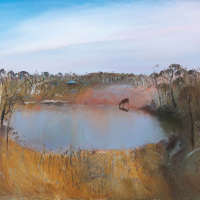28. ARTHUR BOYD

Arthur Boyds early humanist/landscape work, Prodigal Son 1946-7, had been in the family collection of Douglas and Anne Cairns since 1950 until its recent sale on the secondary market. Their original purchase was astute; they were obviously drawn to the earthiness of the image and its placement of man in the landscape. The Cairns family owned an apple orchard on Victorias Mornington Peninsula in the 1950s and Arthur Boyd and his family were frequent visitors. As a young child, Ceci Cairns recalls watching Boyd paint in their orchard.1 This specific immersion for Boyd in the southern light of the Victorian landscape is a crucial one, especially since man in the landscape became a crucial theme for much of his lifes work. The current image Douglas Cairns Dam, painted c1975, is a recollection by Boyd of these early years in this exact location. The distant farmhouse towards the horizon speaks of isolation, its flicker of lights a sign of hope that all is well. It is a small fragment enfolded in the immensity of the landscape that surrounds it. It is a work that shows Boyd completely focused on the signs and symbols that reveal the rural Australian character. This is a beautifully lyrical painting, with an evanescent late spring sky and the mirrored image of a circular dam with an attendant animal drinking at the waters edge.
But this location, timing and subject matter provide insight into the processes of Boyds later works. In 1975, the Boyds occupied a property, Riversdale, near their final home at Bundanon on the Shoalhaven. Boyd was smitten by the environment. He painted directly in the landscape, en plein air, overwhelmed by the brightness of light. This lightness of being is evident in many works from this period. It is evident, for example, in Interior with Open Door, 1976-7, where Boyd conveys the ravishing clarity of light over land and water right outside the open door. An ambiguous half-submerged form is mirrored in the still water. There is a sense of Boyd being close to the landscape but also treading lightly.2
In a deep questioning of the role of light in the landscape, while immersed in the environs of New South Wales Shoalhaven region, Boyd also paints memories of Victorian landscapes on the Mornington Peninsula, using a sky palette of silver-grey evoking fading evening light. Victorian works from this c1976 period show a quietude in the landscape that reminds us of the redemptive aspects of nature.3 This gives a poetic context to the light and lyricism of Douglas Cairns Dam, c1975. Boyd is invoking here both the memory of place and comparison of places.
The structure of the painting is also characteristic of Boyds research. During this period he engaged with the myth of Narcissus, the son of a river god, who fell in love with his own reflection mirrored in the water, unaware that the image could be shattered in an instant if the water were disturbed. The oval of the water and crouching animal in Douglas Cairns Dam is similar to the crouched, more human figure beside the curvature of water in the Riversdale work Interior with Open Door. This crouching figure of man or animal, poised at the waters edge, is always keenly aware of their own reflection which Boyd addresses with inflected symmetry. Perhaps the artist is distilling images from his memory and trying to capture them, before they shatter and drift away.
Footnotes:
1. Perkin, C., Boyds Prodigal Son returns after 50 years, The Australian, 27 August, 2008
2. Hart, D., Arthur Boyd: Agony & Ecstacy, National Gallery of Australia, Canberra, 2014, p140
3. ibid., p143
Professor Peter James Smith BSc (Hons); MSc; M Stats; MFA; PhD